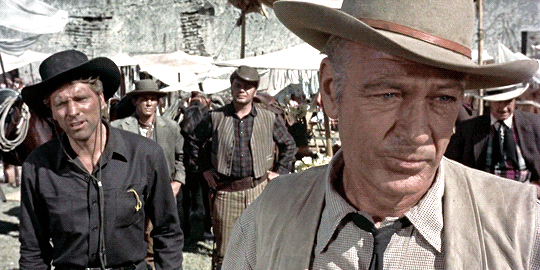« 13 Washington Square | Main | The Last Sunset »
September 28, 2021
Vera Cruz

Robert Aldrich - 1954
KL Studio Classics BD Region A
I wrote about Vera Cruz a little over four years ago. While there will be some repeating of some of my thoughts on the film, there will also be notes on what this new blu-ray version offers.
Much of the contemporary appreciation for Vera Cruz rests on the film's reputation as an influence on Sergio Leone's westerns. The assessment short changes the film as one of the templates for some of Leone's peers. Aside from Burt Lancaster's stylish anti-hero, there is the setting in Mexico during a time of political upheaval, a German military advisor to the main villain, and critiques of colonialism and/or capitalism. All or some of these elements are found in films by Sergio Corbucci, Sergio Sollima, and Carlo Lizzani, among others. Leone was the one who fulfilled his ambition by working with Aldrich on Sodom and Gomorrah, only to find himself disillusioned by his former filmmaking idol.
It is worth noting that the influence of Vera Cruz took place almost a decade later with films primarily shot in Spain, often starring expatriate actors. Aldrich's film marks itself as being a transitional western with the casting of Gary Cooper against Burt Lancaster, not simply stars of different eras and different acting styles, but also with screen personas representing contrasting moral codes. As Henry King discovered when he directed the silent The Winning of Barbara Worth, Gary Cooper underplayed his acting, the camera conveying inner thought and stoicism. Against Cooper's stillness is Lancaster's live wire, emotions on the surface. Much of his performance not only in his physicality, but his smile with those 500 gleaming teeth, two rows rightly called choppers, ready to bite down like a hungry wolf.
Visually, the film very much belongs to Aldrich. High angle, low angle and overhead shots. With Vera Cruz, Aldrich had the budget, time and full confidence to make a film his way with cinematographer Ernest Laszlo, even while forced to compromise on the characterizations at the request of his two stars. Much of the time, the two stars as well as Denise Darcel and Sarita Montiel are filmed in two-shots allowing for immediate comparison of facial expressions. The way the main characters are filmed unites them visually within the same space even when their individual motivations are in conflict. Contemporary filmmakers could also learn from Aldrich on how to film an action packed story with a couple of sub-plots within a running time slight more that ninety minutes.
Filmmaker and historian Alex Cox provides the commentary track. Always well researched, much of the information may be familiar based on previous examinations of the careers of Robert Aldrich and Sergio Leone. The one revelation is that Cary Grant was offered the role taken by Gary Cooper. Cox also points out the various Mexican locations where the film was shot. While Cox does point out the better known henchmen of Lancaster's gang - Ernest Borgnine, Jack Elam and the former Charles Buchinsky, he gives short shrift to Archie Savage. The former dancer associated with Katherine Dunham plays a former Union soldier, still wearing his blue uniform jacket. As Ballard, Savage was, to the best of my knowledge, one of the first black actors to have an active role in a Hollywood western, that is not a western made for black audiences, nor as a comic role. Savage's dancing skills are on display in two scenes, but he is also filmed as a man of action, facing the rest of the gang in defense of Sarita Montiel. There is no information regarding the source for the new blu-ray, but the visual flaws from the MGM blu-ray have been corrected. It is amazing to know that the film was critically lambasted at the time of release, mostly having to do with Lancaster's anti-hero showing no redeeming qualities. Bosley Crowthers in the New York Times opined, "Vera Cruz, to put it bluntly, is pretty atrocious film, loaded with meaningless violence and standard horse opera clichés." Aldrich's film has aged quite nicely as the inspiration for several films that followed, not only in the use of some of the previously mentioned tropes, but also the film's streak of dark humor.
Posted by Peter Nellhaus at September 28, 2021 07:33 AM
